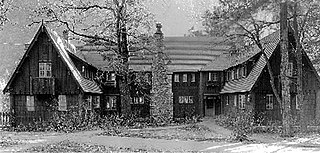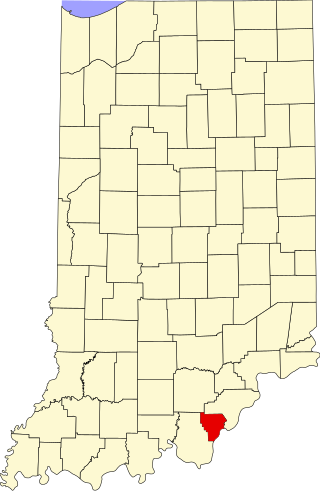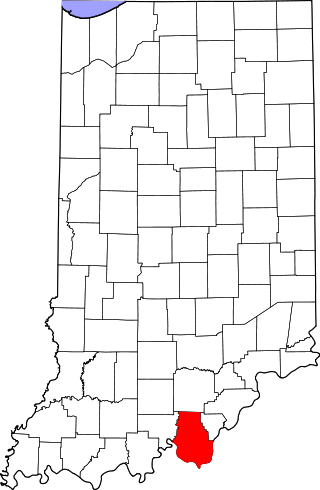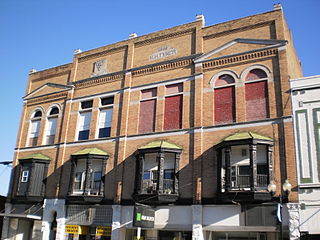
Berkeley Plantation, one of the first plantations in America, comprises about 1,000 acres (400 ha) on the banks of the James River on State Route 5 in Charles City County, Virginia. Berkeley Plantation was originally called Berkeley Hundred, named after the Berkeley Company of England. In 1726, it became the ancestral home of the Harrison family of Virginia, after Benjamin Harrison IV located there and built one of the first three-story brick mansions in Virginia. It is the home to two presidents of the United States: William Henry Harrison, and his grandson Benjamin Harrison. It is now a museum property, open to the public.

Georgetown is a town in Floyd County, Indiana, United States. The population was 3,805 at the 2020 census.

Grouseland, the William Henry Harrison Mansion and Museum, is a National Historic Landmark important for its Federal-style architecture and role in American history. The two-story, red brick home was built between 1802 and 1804 in Vincennes, Indiana, for William Henry Harrison (1773–1841) during his tenure from 1801 to 1812 as the first governor of the Indiana Territory. The residence was completed in 1804, and Harrison reportedly named it Grouseland due to the abundance of grouse in the area.

The Texas Governor's Mansion is a historic home for the governor of Texas in downtown Austin, Texas. Designed by prominent architect Abner Cook, it was built in 1854 and has been the home of every governor since 1856. Governor Greg Abbott and First Lady Cecilia Phalen Abbott are the current residents.

The Colgate Clock, located at a former Colgate-Palmolive factory in Clarksville, Indiana, is one of the largest clocks in the world. It has a diameter of 40 feet. It was first illuminated in Clarksville on November 17, 1924. It is located directly across the Ohio River from Louisville, Kentucky.

The Grisamore House is a historic home located in downtown Jeffersonville, Indiana. It was built by two brothers from Philadelphia, David and Wilson Grisamore, in 1837. It is a 2+1⁄2-story, Federal style brick double house with Greek Revival style design elements. The front facade features three stucco-coated, two-story Doric order columns in antis and two projecting second story balconies. It has housed several Jeffersonville families of importance. Future president William Henry Harrison gave a speech on the front porch in 1840 while campaigning to become president.

The Rangers' Club is a building in Yosemite Valley in Yosemite National Park that was donated by the independently wealthy first director of the National Park Service, Stephen Tyng Mather. He intended it to be used by the newly hired park rangers who were taking over from the departing army troops. He specifically intended it to blend into the natural environment. Its use of rustic stylings was part of a trend to the use of rustic design and natural materials in Park Service buildings until the 1940s.

The John Harrington Stevens House is a historic structure in the U.S. state of Minnesota. Named for John H. Stevens, it was the first authorized house on the west bank of the Mississippi River in what would become Minneapolis. The house is the second oldest remaining wood-frame house in Minneapolis. The house is part of the Minnehaha Historic District and managed by the Minneapolis Park and Recreation Board. The structure was heavily damaged by three acts of arson in 2022.

The Oliver G. Traphagen House, also known as Redstone, is a historic residential building in Duluth, Minnesota, United States. Built in 1892 as a duplex, it was designed and inhabited by architect Oliver G. Traphagen (1854–1932). The building was listed on the National Register of Historic Places in 1975 for its local significance in the theme of architecture. It was nominated for its association with Traphagen, recognized together with his business partner Francis W. Fitzpatrick as Duluth's leading architects of the late 19th century.

This is a list of the National Register of Historic Places listings in Lake County, Indiana.

This is a list of the National Register of Historic Places listings in Vanderburgh County, Indiana.

This is a list of the National Register of Historic Places listings in Clark County, Indiana.

This is a list of the National Register of Historic Places listings in Floyd County, Indiana.

This is a list of the National Register of Historic Places listings in Posey County, Indiana.

This is a list of the National Register of Historic Places listings in Crawford County, Indiana.

This is a list of the National Register of Historic Places listings in Harrison County, Indiana.

The Allenstown Meeting House is a historic meeting house on Deerfield Road in Allenstown, New Hampshire. Built in 1815, it is New Hampshire's only surviving Federal-style single-story meeting house to serve both religious and civic functions. It was listed on the National Register of Historic Places in December 2004, and the New Hampshire State Register of Historic Places in July 2004. It is presently owned and maintained by the town.

The Hartford City Courthouse Square Historic District is located in Hartford City, Indiana. Hartford City has a population of about 7,000 and is the county seat of Blackford County and the site of the county courthouse. The National Park Service of the United States Department of the Interior added the Hartford City Courthouse Square Historic District to the National Register of Historic Places on June 21, 2006 — meaning the buildings and objects that contribute to the continuity of the district are worthy of preservation because of their historical and architectural significance. The District has over 60 resources, including over 40 contributing buildings, over 10 non-contributing buildings, 1 contributing object, 8 non-contributing objects, and two other buildings that are listed separately in the National Register.

The Hermitage was a historic home located at New Castle, New Castle County, Delaware. It was built between about 1700 and 1818, and consisted of three brick sections. The oldest section was the 2+1⁄2-story west wing. There was a two-story, rear kitchen wing, with servant's quarters above. The main section was built in 1818, and was a two-story, three-bay structure. It was built by U.S. Senator Nicholas Van Dyke (1770–1826) as a farm and summer retreat for his family.

Plymouth Downtown Historic District is a national historic district located in Plymouth, Marshall County, Indiana, United States. The district encompasses 47 contributing buildings and one contributing structure in the central business district of Plymouth. It developed between about 1870 and 1940, and includes examples of Italianate, Romanesque Revival, and Colonial Revival style architecture. Located in the district is the separately listed Plymouth Fire Station. Other notable buildings include the Montgomery Ward Building (1929), Metsker Block, Rentschler Building (1910), Early Plymouth Post Office (1884), First National Bank-Plymouth City Hall, Packard Bank Block (1879), Simons Building (1895), Wheeler Block, Bank Block, Bank Block-Masonic Temple (1901), Plymouth Post Office (1935), and Plymouth Motor Sales (1929).

























